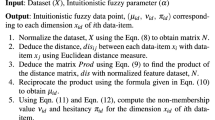Abstract
Clustering in web analytics extracts information from data based on similarity measurement on the data patterns, where similar data patterns are grouped as a cluster. However, the typical clustering methods used in web analytics suffer from three major shortcomings, viz., (1) the predefined number of clusters is hard to determined when new data are generated over time; (2) new data might not be adopted into the existing clusters; and (3) the information given by a cluster (centroid) is vague. In this study, an incremental learning method using the Fuzzy Adaptive Resonance Theory (Fuzzy ART) algorithm is adopted (1) to analyze the underlying structure (hidden message) of the data, and (2) to interpret cluster into an understandable and useful knowledge about user activity on a webpage. An experimental case study was conducted by capturing the integrated data from Google Analytics on the University of Technology Sarawak (UTS), Malaysia, website to analyze user activity on the webpage. The results were analyzed and discussed, and it shown that the information obtained at each cluster can be interpreted in term of cluster boundary at each feature space (dimension), whereas the user activity are explained from the cluster boundary without revisiting the trained data.
Access this chapter
Tax calculation will be finalised at checkout
Purchases are for personal use only
Similar content being viewed by others
References
Król, K.: The application of web analytics by owners of rural tourism facilities in Poland–diagnosis and an attempt at a measurement. J. Agribus. Rural Dev. 54(4), 319–326 (2019)
Kö, A., Kovacs, T.: Business analytics in production management–challenges and opportunities using real-world case experience. In: Working Conference on Virtual Enterprises, pp. 558–566 (2021)
Nazar, N., Shukla, V.K., Kaur, G., Pandey, N.: Integrating web server log forensics through deep learning. In: 2021 9th International Conference on Reliability, Infocom Technologies and Optimization (Trends and Future Directions) (ICRITO), pp. 1–6 (2021)
Terragni, A., Hassani, M.: Analyzing customer journey with process mining: from discovery to recommendations. In: 2018 IEEE 6th International Conference on Future Internet of Things and Cloud (FiCloud), pp. 224–229 (2018)
Tamilselvi, T., Tholkappia Arasu, G.: Handling high web access utility mining using intelligent hybrid hill climbing algorithm based tree construction. Clust. Comput. 22(1), 145–155 (2018). https://doi.org/10.1007/s10586-018-1959-8
Nasraoui, O., Soliman, M., Saka, E., Badia, A., Germain, R.: A web usage mining framework for mining evolving user profiles in dynamic web sites. IEEE Trans. Knowl. Data Eng. 20(2), 202–215 (2008)
Li, N., Shepperd, M., Guo, Y.: A systematic review of unsupervised learning techniques for software defect prediction. Inf. Softw. Technol. 122(February 2019), 106287 (2020)
Sinaga, K.P., Yang, M.: Unsupervised K-means clustering algorithm. IEEE Access 8, 80716–80727 (2020)
Fabra, J., Álvarez, P., Ezpeleta, J.: Log-based session profiling and online behavioral prediction in e-commerce websites. IEEE Access 8, 171834–171850 (2020)
Janmaijaya, M., Shukla, A.K., Muhuri, P.K., Abraham, A.: Industry 4.0: Latent Dirichlet Allocation and clustering based theme identification of bibliography. Eng. Appl. Artif. Intell. 103, 104280 (2021)
Chang, A.C., Trappey, C.V., Trappey, A.J., Chen, L.W.: Web mining customer perceptions to define product positions and design preferences. Int. J. Semant. Web Inf. Syst. 16(2), 42–58 (2020)
Pehlivan, N.Y., Turksen, I.B.: A novel multiplicative fuzzy regression function with a multiplicative fuzzy clustering algorithm. Rom. J. Inf. Sci. Technol. 24(1), 79–98 (2021)
Borlea, I.D., Precup, R.E., Borlea, A.B.: Improvement of K-means cluster quality by post processing resulted clusters. Procedia Comput. Sci. 199, 63–70 (2022)
Chang, W.L., Tay, K.M., Lim, C.P.: Clustering and visualization of failure modes using an evolving tree. Expert Syst. Appl. 42(20), 7235–7244 (2015)
Chang, W.L., Pang, L.M., Tay, K.M.: Application of self-organizing map to failure modes and effects analysis methodology. Neurocomputing 249, 314–320 (2017)
Chang, W.L., Tay, K.M.: A new evolving tree for text document clustering and visualization. In: Soft Computing in Industrial Applications, vol. 223. Springer (2014)
Chang, W.L., Tay, K.M., Lim, C.P.: A new evolving tree-based model with local re-learning for document clustering and visualization. Neural Process. Lett. 46(2), 379–409 (2017). https://doi.org/10.1007/s11063-017-9597-3
Khan, I., Luo, Z., Huang, J.Z., Shahzad, W.: Variable weighting in fuzzy k-means clustering to determine the number of clusters. IEEE Trans. Knowl. Data Eng. 32(9), 1838–1853 (2019)
Su, H., Qi, W., Hu, Y., Karimi, H.R., Ferrigno, G., De Momi, E.: An incremental learning framework for human-like redundancy optimization of anthropomorphic manipulators. IEEE Trans. Ind. Inform. 18(3), 1864–1872 (2020)
Li, X., Zhou, Y., Wu, T., Socher, R., Xiong, C.: Learn to grow: a continual structure learning framework for overcoming catastrophic forgetting. In: International Conference on Machine Learning, pp. 3925–3934 (2019)
Carpenter, G., Grossberg, S., Markuzon, N., Reynolds, J.H.: Fuzzy ARTMAP: a neural network architecture for incremental supervised learning of analog. IEEE Trans. Neural Netw. 3(5), 220–226 (1992)
Lughofer, E.: Evolving Fuzzy Systems Methodologies, Advanced Concepts and Applications, vol. 266 (2011)
Author information
Authors and Affiliations
Corresponding author
Editor information
Editors and Affiliations
Rights and permissions
Copyright information
© 2023 The Author(s), under exclusive license to Springer Nature Switzerland AG
About this paper
Cite this paper
Chang, WL., Ong, SL., Ling, J. (2023). Incremental Cluster Interpretation with Fuzzy ART in Web Analytics. In: Abraham, A., Hong, TP., Kotecha, K., Ma, K., Manghirmalani Mishra, P., Gandhi, N. (eds) Hybrid Intelligent Systems. HIS 2022. Lecture Notes in Networks and Systems, vol 647. Springer, Cham. https://doi.org/10.1007/978-3-031-27409-1_46
Download citation
DOI: https://doi.org/10.1007/978-3-031-27409-1_46
Published:
Publisher Name: Springer, Cham
Print ISBN: 978-3-031-27408-4
Online ISBN: 978-3-031-27409-1
eBook Packages: Intelligent Technologies and RoboticsIntelligent Technologies and Robotics (R0)




